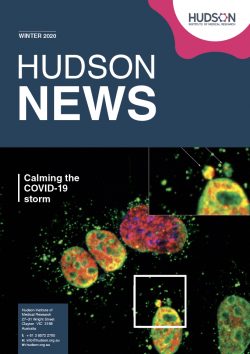There is something unusual about the initial—or innate—immune response to COVID-19 compared to usual influenza patterns.
The disease severity is surprisingly low in children, but high in older people. Our innate immune response provides early antiviral protection and shapes the immunity required later for vaccine responses. But, if uncontrolled, the resulting hyper-acute inflammation from excess cytokines can lead to potentially lethal ARDS.
A Hudson Institute and Monash Health collaboration between Professor Paul Hertzog, Dr Sam Forster, Professor Phil Bardin, Professor Marcel Nold and Professor Jim Buttery will study the innate immune response of COVID-19-infected patients admitted to Monash Health wards, comparing those who have mild disease and recover, with those who suffer severe disease requiring intensive care. The study will compare disease in adults and children.
This collaboration demonstrates the benefits of the Institute’s location onsite at Melbourne’s largest healthcare network, Monash Health—enabling this exciting translational project to occur.
How we are tackling acute inflammation
- Does the anti-viral interferon response (inflammatory signalling proteins) align with disease severity?
- Which inflammatory cytokines influence development of severe lung disease?
- Does the immune cell response dictate protection, or drive long-term immunity?
- How does the lung microbiome influence the innate immune response including inflammation?
Why is research into the innate immune response needed?
“We don’t understand why some people have mild disease and recover, while others develop life-threatening illness,” Prof Paul Hertzog said. “This includes the apparent ‘resistance’ of young people and sensitivity of older patients.” This study aims to study everything from patient genetics, to the nature of their immune cells and the molecules they produce.
Understanding early immune responses to COVID-19 will help scientists design vaccines to optimise successful protection.
Prof Hertzog said the response to the COVID-19 pandemic highlights the global scientific community’s ability to work at pace, thanks to the latest cutting-edge technology and highly skilled scientists. “We have seen remarkable advances in the ability of the international scientific community to respond to a crisis such as this pandemic. The virus was isolated and its whole genome sequenced in three days, enabling tests to be available quickly, and vaccine projects to begin at an unprecedented pace,” he said. “Nevertheless, a vaccine would take at least 12 to 18 months to develop.”
In the interim, he said there was much more work to be done around the potential to harness innate immunity to fight pandemic and/or drug-resistant infections or respond to health issues by developing better immune biomarkers for disease diagnosis and surveillance, or immunotherapeutics and vaccines for treatment and prevention.
The benefit of targeting the innate immune response is the existence of common elements regardless of the infection—COVID, SARS, EBOLA, and antibiotic-resistant bacteria. This complements approaches that do target specific infections, such as antiviral drugs, vaccines and antibiotics.
Professor Paul Hertzog
Centre Head, Centre for Innate Immunity and Infectious Diseases
Collaborators
Dr Sam Forster, Research Group Head, Microbiota and Systems Biology
Professor Phil Bardin, Research Group Head, Respiratory and Lung; Head of Unit, Respiratory and Sleep, Monash Health
Professor Marcel Nold, Research Group Head, Interventional Immunology in Early Life Diseases; paediatrician, Monash Health
Professor Jim Buttery, Head of Unit, Infection and Immunity, Monash Children’s Hospital
Funders
This project requires funding for analysis.

